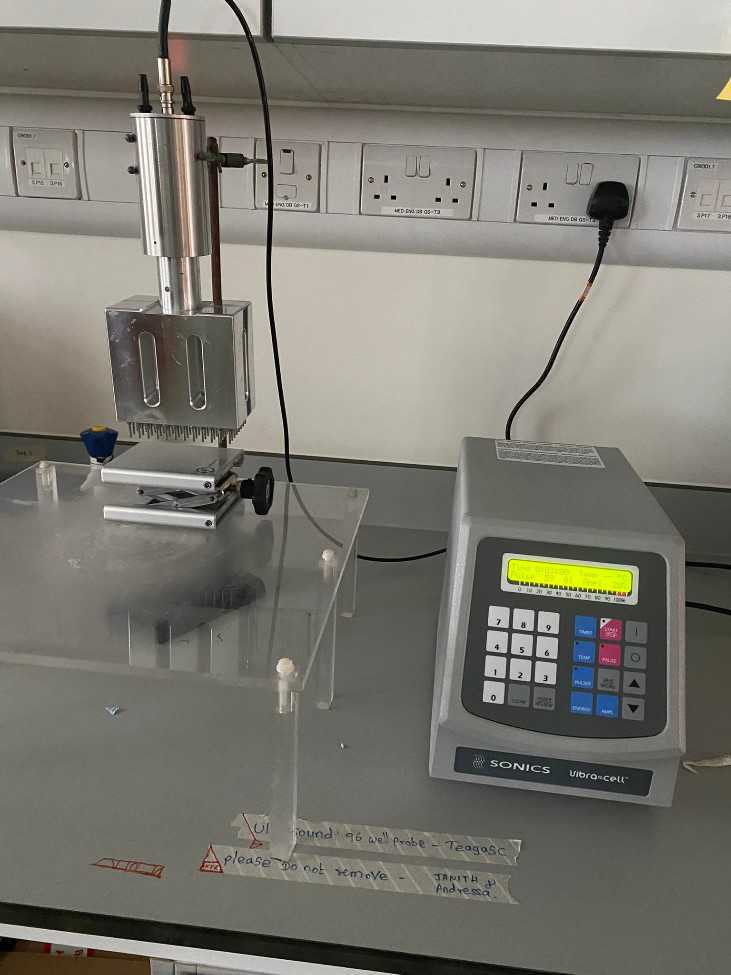Ultrasound 96 Probe Device Protocol for cancer cell treatment
Aisling Field, Brijeshtiwari, James F Curtin, Julie Rose Mae Mondala, Janith Wanigasekara
Disclaimer
DISCLAIMER – FOR INFORMATIONAL PURPOSES ONLY; USE AT YOUR OWN RISK
The protocol content here is for informational purposes only and does not constitute legal, medical, clinical, or safety advice, or otherwise; content added to protocols.io is not peer reviewed and may not have undergone a formal approval of any kind. Information presented in this protocol should not substitute for independent professional judgment, advice, diagnosis, or treatment. Any action you take or refrain from taking using or relying upon the information presented here is strictly at your own risk. You agree that neither the Company nor any of the authors, contributors, administrators, or anyone else associated with protocols.io, can be held responsible for your use of the information contained in or linked to this protocol or any of our Sites/Apps and Services.
Abstract
Ultrasound is a sound wave with frequencies ranging between 20 kHz and 20 MHz. Ultrasound is able to temporarily and repeatedly open the BBB safely and enhance chemotherapeutic delivery without adverse effects.(Deprez et al., 2021). This novel technique in drug delivery benefits from the powerful ability of ultrasound to produce cavitation activity. Cavitation is the generation and activity of gas-filled bubbles in a medium exposed to ultrasound. As the pressure wave passes through the media, gas bubbles expand at low pressure and contract at high pressure. This leads to oscillation which produces a circulating fluid flow known as microstreaming around the bubble with velocities and shear rates proportional to the amplitude of the oscillation. At high amplitudes the associated shear forces can cut open liposomes (Wanigasekara et al., 2021; Deprez et al., 2021).
Vesicles denser than the surrounding liquid are drawn into the shear field surrounding an oscillating bubble. If the shear stress is greater than the strength of the vesicle, it will burst and spill its contents. In a liposome, the vesicle will reform, often at a smaller size than before meeting the shear field. Hence, some interior liquid must be released during the break down. (Pitt et al., 2004)
This protocol describes the use of an ultrasound probe to trigger the release of liposomes in glioblastoma cells. This method uses an ultrasound device which is set to the following parameters: Time = 3 min, Pulse = 59 /01, Amplitude = 20%. The ultrasound technique is an easy and reliable technique making it useful in the study of a variety of areas such as oncology. When applied to an ultrasonic transducer, the Pulser part of the instrument generates short, large amplitude electric pulses of controlled energy, which are transformed into short ultrasonic pulses.
The VCX 750 is the ultrasonic liquid processor used for this experiment. It is powerful and versatile and can process a wide range of sample types and volumes for many different applications.
Before start
Steps
Before starting the ultrasound probe system, ensure that all parts of the system/device are free from mechanical damage and that the probe is connected tightly.

The 96-probe system is designed to fit perfectly into the 96 well plate, which can be used to grow and treat cancer cells. The retort stand is used to hold the Ultrasound 96 probe unit vertically. A laboratory Jack is used to hold the cancer cells grown in the 96 well plate and to move it towards the 96 probes.
A Sonics - Vibra cell power unit is needed to fix into ultrasound 96 probe. Using the power unit, the ultrasound treatment time (0 to 99 min), temperature, pulser, and amplitude can be controlled. Experiments found that the best parameters to use are 20% amplitude, Pulses of 59 seconds on and 1 second off with different time ranges (1, 3, 5, 10, and 20 min).

For 2D cell culture assays using a 96-well seed plate, seed cells in 100 μl of the appropriate media. For 3D cell culture assays using a Nunclon™ Sphera™ 96-Well plate, seed cells in 200 μl of the appropriate media. Leave 2D cells to adhere overnight at 37 ℃ in a humidified atmosphere at a density of 2 x 10^3 cells/well or 1 x 10^4 cells/well for 96 hours incubation time post-treatment and 24 hours incubation time post-treatment, respectively. During 3D cells, spheroids will usually form in 3-7 days from the starting date depending on seeding density.
On the day of ultrasound treatment, remove the culture media from the plates and add 100µl fresh media into each plate. It is Important that during ultrasound treatment all the 96 probe tips are immersed inside media/ any liquid). There mustn't be any empty wells, hence 100ul of media should be added into each well.

Place the sample (plate without lid) in the centre of the laboratory Jack and slowly move into the 96 probe. 2mm distance must be kept from the bottom of the well to the probe tip during the treatment. After setting up the unit, the device is turned on. The samples are treated with the ultrasound using the parameters that were set.
Following treatment, remove the sample plates from the probe system and carry out post treatment incubation at 37 ℃ using 5% CO2. Dimethyl sulfoxide (DMSO) (20%) is used as a positive control. Ultrasound treated cells / tumorspheres are then used for further analysis.

